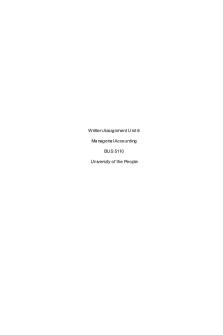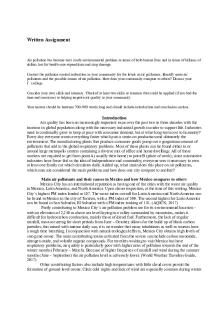BUS5110 Unit 6 Written Assignment PDF

| Title | BUS5110 Unit 6 Written Assignment |
|---|---|
| Author | Eman Kojah |
| Course | Written assignment unit 6 |
| Institution | University of the People |
| Pages | 5 |
| File Size | 116.4 KB |
| File Type | |
| Total Downloads | 326 |
| Total Views | 480 |
Summary
Written Assignment Unit 6Managerial AccountingBUS 5110University of the PeopleIntroduction This written assignment is regarding a case of a manufacturing company evaluating two options for new equipment. The details are given in the case description and we will be calculating three main capital budg...
Description
Written Assignment Unit 6 Managerial Accounting BUS 5110 University of the People
Introduction This written assignment is regarding a case of a manufacturing company evaluating two options for new equipment. The details are given in the case description and we will be calculating three main capital budgeting calculations: NPV, IRR, and Payback Period.
First, let us organize the data and perform the calculations. The cost for equipment and the costs for maintenance, materials, and labor are charted by year. The total cash flow for each year is then calculated for each year.
NPV According to (Fernando, 2021), “Net present value (NPV) is the difference between the present value of cash inflows and the present value of cash outflows over a period of time. NPV is used in capital budgeting and investment planning to analyze the profitability of a projected investment or project.” We first calculate the PV factor and multiply it with cash flow to find PV. The NPV is then calculated by adding all the values (all inflows - all outflows).
IRR “The internal rate of return (IRR) is a metric used in financial analysis to estimate the profitability of potential investments. IRR is a discount rate that makes the net present value (NPV) of all cash flows equal to zero in a discounted cash flow analysis” (Fernando, 2021). We use the IRR formula to calculate the value.
Payback Period According to (Kagan, 2021), “The term payback period refers to the amount of time it takes to recover the cost of an investment. Simply put, the payback period is the length of time an
investment reaches a break-even point.” This is relatively straightforward. We simply add the cashflows and note down the year where they break even.
Option 1 $75,000 for equipment, 7 years, no salvage value Maintenance: $2,500 per year for the first 5 years, increase by 3% in year 6 Materials: 20,000 in year 1, and 10,000 per year starting from year 2 Labor: 50,000 in year 1, and increasing by 3% each year The required rate of return is 8% Year 0
Year 1
Year 2
Year 3
Year 4
Year 5
Year 6
Year 7
-
$50,000
$113,000
$125,000
$125,000
$150,000
$150,000
Maintenance
$2500
$2500
$2500
$2500
$2500
$2575
$2575
Materials
$20,000
$10,000
$10,000
$10,000
$10,000
$10,000
$10,000
Labor
$50,000
$51,500
$53,045
$54,636
$56,275
$57963
$59701
Total Cashflow
-$72,500
-$14,000
$47,455
$57,864
$56,225
$79,462
$77,724
PV Factor (r=8%)
0.926
0.857
0.793
0.735
0.735
0.630
0.630
-67135
-11998
37632
42530
41325
50061
48966
-$147,50 0
-$161,50 0
-$114,04 5
-$56,181
$44
$79,506
$157,230
Revenue Purchase
-$75,000
PV
-$75,000
NPV
$66,381
IRR
16.238%
Payback
-$75,000
Analysis: Favorable NPV is positive. This outcome favors option 1. IRR is 16.238%, which is pretty good and much higher than option 2. This outcome also favors option 1. Payback is in year 5, which is earlier than option 2. This outcome also favors option 1.
Option 2 $50,000 for equipment, 7 years, $10,000 salvage value Maintenance: $4,500 per year for the first 5 years, increase by 3% in year 6 Materials: 25,000 in year 1, and 20,000 per year starting from year 2 Labor: 70,000 in year 1, and increasing by 3% each year The required rate of return is 8% Year 0
Year 1
Year 2
Year 3
Year 4
Year 5
Year 6
Year 7
-
$75,000
$100,000
$125,000
$155,000
$200,000
$150,000
Maintenance
$4500
$4500
$4500
$4500
$4500
$4575
$4575
Materials
$25,000
$20,000
$20,000
$20,000
$20,000
$20,000
$20,000
Labor
$70,000
$72,100
$74,263
$76,491
$78,786
$81,149
$83,584
Total Cashflow
-$99,500
-$21,600
$1,237
$24,009
$51,714
$94,276
$41,841
PV Factor (r=8%)
0.926
0.857
0.793
0.735
0.735
0.630
0.630
-92137
-18511
981
17647
38010
59394
26360
-$149,50 0
-$171,10 0
-$169,86 3
-$145,85 4
-$94,140
$136
$41,977
Revenue Purchase
-$50,000
PV
-$50,000
NPV
-$18,256
IRR
4.612% -$50,000
Analysis: Unfavorable NPV is negative. This outcome is inferior to option 1. IRR is 4.612%, which is not very good and lower than option 1. Payback is in year 6, which is later than option 1.
My Suggestion is to pursue option 1. It has a positive NPV, higher IRR, and earlier payback period.
Conclusion This case is a prime example of how manufacturers would evaluate two options for their manufacturing equipment. This is a very useful tool because it gives a clear view of the two options, how they will perform and when they would break even. Of course, this is not the only consideration the management will have to consider. There are many other factors that extend beyond numbers. However, this study remains a useful reference to the process.
References Fernando, J. (2021, April 07). Internal Rate of Return (IRR). Investopedia. https://www.investopedia.com/terms/i/irr.asp Fernando, J. (2021, August 29). Net Present Value (NPV). Investopedia. https://www.investopedia.com/terms/n/npv.asp Kagan, J. (2021, Sep 20). Payback Period. Investopedia. https://www.investopedia.com/terms/p/paybackperiod.asp...
Similar Free PDFs

Written Assignment Unit 6
- 8 Pages

Written Assignment Unit 6
- 4 Pages

Unit 6 - Written Assignment
- 4 Pages

Written Assignment Unit 6 wa
- 4 Pages

Written Assignment Unit 2
- 3 Pages

Written Assignment Unit 7
- 3 Pages

Written Assignment UNIT 5
- 6 Pages

Written Assignment Unit 2
- 5 Pages

Written Assignment Unit 2
- 1 Pages

Written Assignment Unit 3
- 4 Pages
Popular Institutions
- Tinajero National High School - Annex
- Politeknik Caltex Riau
- Yokohama City University
- SGT University
- University of Al-Qadisiyah
- Divine Word College of Vigan
- Techniek College Rotterdam
- Universidade de Santiago
- Universiti Teknologi MARA Cawangan Johor Kampus Pasir Gudang
- Poltekkes Kemenkes Yogyakarta
- Baguio City National High School
- Colegio san marcos
- preparatoria uno
- Centro de Bachillerato Tecnológico Industrial y de Servicios No. 107
- Dalian Maritime University
- Quang Trung Secondary School
- Colegio Tecnológico en Informática
- Corporación Regional de Educación Superior
- Grupo CEDVA
- Dar Al Uloom University
- Centro de Estudios Preuniversitarios de la Universidad Nacional de Ingeniería
- 上智大学
- Aakash International School, Nuna Majara
- San Felipe Neri Catholic School
- Kang Chiao International School - New Taipei City
- Misamis Occidental National High School
- Institución Educativa Escuela Normal Juan Ladrilleros
- Kolehiyo ng Pantukan
- Batanes State College
- Instituto Continental
- Sekolah Menengah Kejuruan Kesehatan Kaltara (Tarakan)
- Colegio de La Inmaculada Concepcion - Cebu





